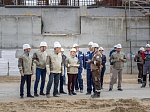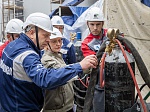27.09.2019
THE KURSK NPP INFORMATION AND PUBLIC RELATIONS DEPARTMENT
The Rostekhnadzor commission has verified the quality of works delivered at the Kursk NPP-2 construction site
On September 26, 2018, the commission of the Rostekhnadzor’s North-European cross-regional area administration of overseeing nuclear and radiation safety together with their colleagues from the Upper-Don administration has completed the on-site verification of the Kursk NPP-2 replacement 1st and 2nd power blocks under construction as well as the radioactive waste handling complex at the Kursk NPP.
‘The main goal of the commission was to make sure that the customer and the general contractor have not violated the terms of their license for the construction of the VVER-TOI 1st and 2nd power blocks’, Alexey Volnov, the chief engineer of the Kursk NPP-2, said while also noting that the commission comprised top-notch specialists.
During the verification that started on September 17th, the experts paid special attention to how the federal standards and regulations are observed when organizing construction and assembly activities at the capital construction objects, starting with the project documentation and up to the technical issues, radiation safety, compliance with the project, fire safety regulations, and sanitary and epidemiological welfare. The inspectors have reviewed the working materials, the regulatory, administrative and operational documents, had walk-overs at the production units and spoke to the staff.
As a result of the completed activities, the experts didn’t find any violations of the federal regulations and standards with regard to the nuclear energy usage pursuant to the terms of the licenses to operate in this area.
‘The construction process at the Kursk NPP-2 site is organized in a perfect manner. Being specialists in the nuclear and radiation safety, we appreciate that proper implementation and control of construction works pre-define the safety at the operational stage. And if you follow the right approach, you can detect and prevent possible issues straight away’, Alexandr Polin, the deputy head of the Rostekhnadzor’s North-European cross-regional area administration of overseeing nuclear and radiation safety, stated.
Such scheduled verifications are regularly held as a part of the construction oversight at the Kursk NPP-2. The next construction supervision inspection at the construction site is scheduled for spring 2020.
It is important to note that, at the moment, works are carried out at 19 objects of the Kursk NPP-2 construction site according to the schedule, which involves around 3,900 construction and assembly workers. In 2019, all scheduled governmental assignments were completed on time: in March, the core melt localization device (the so-called ‘melt trap’) was installed at the 1st power block, and the concreting of the reactor building’s foundation was completed at the 2nd power block. As of now, 7 out of 11 milestones of this year’s construction have been attained.
The Kursk NPP-2 is a replacement power plant encompassing 2 blocks with the capacity of 1255 megawatt each. The plant is constructed following the VVER-TOI project (general designer – AO Atomenergoproyekt (a part of the ASE Group), general contractor – ASE Group). The Kursk NPP-2 replacement power blocks No.1 and No.2 are being constructed based on the cutting-edge VVER-TOI (Water-Water Energy Reactor Universal Optimized Digital) project. This is a new design created by Russian specialists based on the VVER-1200 NPP technical solutions. These 3+ generation power blocks possess improved technical and economic parameters: compared to the previous-generation power blocks (VVER-1000), the capacity of each has been increased by 25%, up to 1255 megawatt. The major equipment’s life span has doubled. Compared to other power blocks, the VVER-TOI projects stipulate considerable reduction of construction and operational costs as well as the time lines. This design also combines passive and active safety systems. In particular, VVER-TOI includes a core melt localization device as one of the means of controlling accidents outside of the design. This is a unique Russian safety technology that guarantees safety management.



 career
career Innovations
Innovations Projects
Projects INTERNATIONAL BUSINESS
INTERNATIONAL BUSINESS